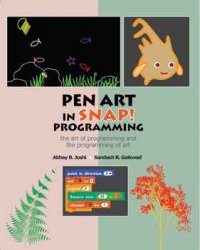 Название: Pen Art in Snap Programming: the art of programming and the programming of art
Название: Pen Art in Snap Programming: the art of programming and the programming of art Автор: Abhay B. Joshi, Sandesh R. Gaikwad
Издательство: SPARK Institute and Publications
ISBN: 1093754710
Год: 2019
Страниц: 190
Язык: английский
Формат: epub
Размер: 10.1 MB
Snap (and Scratch, from which Snap was derived) borrowed the pen feature from another older language called “Logo”. And Logo contained a single sprite – a triangular shape called “Turtle”! This Turtle had a pen attached to it. And so, as it followed instructions and was moved around on the screen, it drew lines. Hence, the entire field of drawing shapes in Logo came to be called “Turtle Programming”. There is even a field of geometry called “Turtle Geometry”. Modern languages, such as Python, have the aptly-named “Turtle” libraries that implement the drawing feature of Logo. Snap, being a descendant of Logo, includes the Pen. Every sprite in Snap has a pen attached to it (just like the Turtle did in Logo). When the pen is put down (using the “pen down” command), the sprite starts drawing on the screen as it moves around. Since our focus in this book is entirely on “Pen Art” we have no use for the hundreds of costumes provided by the Snap library. We will use the original triangle-shaped costume called “Turtle” in all our Snap programs in this book.
In this book, we are going to focus on the “Pen” feature of the popular Snap! programming language. Henceforth we will refer to "Snap!" simply as "Snap".It is assumed that the reader is familiar with the basic features of Snap, such as, motion commands and looping. There is a lot of material on Snap Programming on the Internet, including videos, online courses, Snap projects, and so on. We highly recommend the book “Learn CS Concepts with Snap” by one of the authors, if you are a complete newcomer to Snap, or if you wish to brush up on your concepts.
However, as you will discover, you can become an accomplished “Pen Artist” (or “Turtle Programmer”) without having to be an expert Snap programmer. We have explained relevant Snap commands and concepts wherever required.
Who this book is for:
This book is expected to allow anyone to experience the magic of Turtle programming. You can read and understand the concepts presented, try out sample programs, and exercise your creativity by trying out the exercises. There are plenty of examples presented along with their results.
The book is meant for CS students of all ages, teachers, parents, and really anyone who wants to get the wonderful taste of the entertaining and creative aspect of Computer Programming.
Why learn programming:
The idea of using computer programming as a medium for learning is rapidly gaining acceptance. The benefits of learning programming and computer science concepts well before college – even in elementary grades – are well-understood. Here is a list of some of the amazing things that happen when children and young adults engage in computer programming:
- They become active and creative learners, because they explore ideas through a hands-on activity with an infinitely powerful tool.
- They learn to think about and analyze their own thinking, because that is the only way to program computers.
- They learn to solve complex problems by breaking them into smaller sub-problems.
- They learn a new way of thinking (called "computational" thinking).
- In the world of programming, answers are not simply "right" or "wrong"; this prepares a student's mindset for real-life problems.
- The learning process is transformed from acquiring facts to thinking creatively and analytically.
How the book is organized:
The book is organized as a series of chapters - each containing a bunch of concepts and associated programming activities. Every chapter includes review questions and several programming assignments that will help you practice all the concepts learnt till then. Answers to all “review questions” and links to working programs for most of the programming exercises in the book are available online.
Contents:
Скачать Pen Art in Snap Programming: the art of programming and the programming of art
